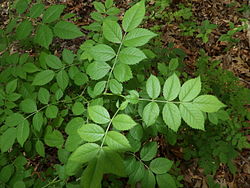Top Qs
Timeline
Chat
Perspective
Rosa multiflora
Species of flowering plant in the rose family Rosaceae From Wikipedia, the free encyclopedia
Remove ads
Rosa multiflora (syn. Rosa polyantha)[2] is a species of rose known commonly as multiflora rose,[3] baby rose,[3] Japanese rose,[3] many-flowered rose,[3] seven-sisters rose,[3] Eijitsu rose and rambler rose. It is native to eastern Asia, in China, Japan, and Korea. It should not be confused with Rosa rugosa, which is also known as "Japanese rose", or with polyantha roses which are garden cultivars derived from hybrids of R. multiflora. It was introduced to North America, where it is an invasive species, forming extensive, impenetrable stands within forest understories, thickets, borders, and lowlands.
Remove ads
Description
It is a scrambling shrub climbing over other plants to a height of 3–5 m (9 ft 10 in – 16 ft 5 in), with stout stems with recurved prickles (sometimes absent). The leaves are 5–10 cm (2–4 in) long, compound, with 5–9 leaflets and feathered stipules. The flowers are produced in large corymbs, each flower small, 1.5–4 cm (5⁄8–1+5⁄8 in) diameter, white or pink, borne in early summer. The hips are reddish to purple, 6–8 mm (15⁄64–5⁄16 in) diameter. Two other varieties have been identified which have many synonyms of their own:[1]
- Rosa multiflora var. adenochaeta (Koidz.) Ohwi
- Rosa multiflora var. cathayensis Rehder & E.H.Wilson
As well as the type variety Rosa multiflora var. multiflora.
Remove ads
Cultivation and uses
Rosa multiflora is grown as an ornamental plant and also used as a rootstock for grafted ornamental rose cultivars.
In eastern North America, Rosa multiflora is considered an invasive species. It was originally introduced from Asia as a soil conservation measure, as a natural hedge to border grazing land, and to attract wildlife. In some regions the plant is classified as a noxious weed.[4] In grazing areas, it is generally considered to be a serious pest, though it is excellent fodder for goats.[5]
The achene fruits (hips) of Rosa multiflora (referred to as "Eijitsu" or "Rosae fructus") are used to make a tea and in traditional medicine historically and in modern clinical practice to treat constipation.[6][7]
Remove ads
Management
The targeted removal of multiflora rose often requires an aggressive technique, such as the full removal of the plant in addition to the root structure. Pruning and cutting back of the plant often leads to re-sprouting. Two natural biological controls include the rose rosette disease and the rose seed chalid (Megastigmus aculeastus var. nigroflavus).[8] Patches of introduced multiflora rose in Pennsylvania are displaying symptoms of rose rosette disease, which can lead to decline and death.[9]
Gallery
- Hips (fruits)
- Blossom of var. cathayensis on the Kuma River of Japan.
References
External links
Wikiwand - on
Seamless Wikipedia browsing. On steroids.
Remove ads








